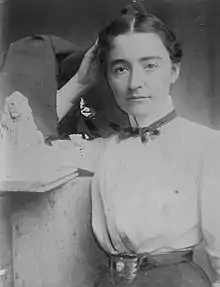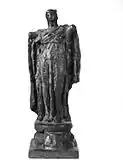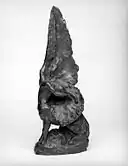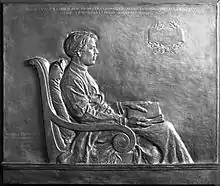Helen Farnsworth Mears | |
|---|---|
 Helen Farnsworth Mears | |
| Born | December 21, 1872 |
| Died | February 17, 1916 (aged 43) |
| Education | State Normal School in Oshkosh |
| Known for | American sculptor |
| Notable work | marble statue of Frances E. Willard |
| Movement | "White Rabbits" |
| Patron(s) | Augustus Saint Gaudens |
Helen Farnsworth Mears (/mɪərs/; December 21, 1872 – February 17, 1916) was an American sculptor.[1]
Early years
Mears was born December 21, 1872, in Oshkosh, Wisconsin, daughter of John Hall Mears and [2] Elizabeth Farnsworth Mears (pen names "Nellie Wildwood" and "Ianthe", called the first Wisconsin poetess [3]) and youngest sister to Louise and Mary Mears. Mears studied at the State Normal School in Oshkosh,[4] and art in New York City. In New York, she studied under Augustus Saint Gaudens for two years and worked as his assistant[5] before heading to Paris in 1895 to continue working with Denys Puech (sometimes Puesch), Alexandre Charpentier, and Frederick MacMonnies.[6][7]
Career
Her first success, before any formal art training, was "Genius of Wisconsin", a work commissioned by the State of Wisconsin when she was just 21. The work was exhibited in the Wisconsin Building at the World's Columbian Exposition in 1893.[8] The 9-foot (2.7 m) marble sculpture was executed by the Piccirilli Brothers.[9] It is now housed in the Wisconsin State Capitol.[10] Both she and sculptor Jean Pond Miner were named "artists in residence" at the Wisconsin Building, and that is where she created The Genius of Wisconsin, while Miner produced Forward.[11]
Mears was one of a group of women sculptors christened the "White Rabbits" who worked under Lorado Taft producing sculpture for the World Columbian Exposition.[12]
In 1907, Mears, and her sister, writer Mary Mears, were the first colonists at MacDowell Colony.[13]
Important works
Her most important works include a marble statue of Frances E. Willard (1905, Capitol, Washington) that is included in the National Statuary Hall Collection; portrait reliefs of Edward MacDowell (Metropolitan Museum, New York); and Augustus St. Gaudens; portrait busts of George Rogers Clark and William T.G. Morton, M. D. (Smithsonian Institution, Washington). In 1904, her "Fountain of Life" (St. Louis Exposition) won a bronze medal. She made New York her residence and exhibited there and in Chicago.
Statue of Wisconsin
In 1910, George B. Post, the architect of the Wisconsin State Capitol then being designed, attempted to secure the services of the well-known sculptor Daniel Chester French to create a statue of Wisconsin to be placed on top of the dome. French, having as much work as he desired, turned the commission down, and Post recommended Mears for the job. With the belief that she had the contract, she began working on a model; she ultimately created three models, with two of them receiving feedback from the commission.[14] By August 1911, Post suggested that Mears could not complete the design in their time frame, and the commission ultimately selected French to complete the sculpture.[14] Mears was paid $1,500 for the work that she had already done, but the loss of the commission was a shock from which she never recovered.[15][16]
Death
Following the debacle surrounding the Wisconsin Capitol statue, Mears's health declined, as did her financial well-being. She died of heart disease on February 17, 1916, at the age of 43.[7][17][18] At the time of her death, she was working in her studio at 46 Washington Square South, in Greenwich Village.
Gallery
 Genius of Wisconsin Helen Farnsworth Mears
Genius of Wisconsin Helen Farnsworth Mears Death Uncovering Its Face and Showing It To Be Life by Helen Farnsworth Mears, 1916
Death Uncovering Its Face and Showing It To Be Life by Helen Farnsworth Mears, 1916 Sketch for Fountain of Silence and Meditation by Helen Farnsworth Mears, 1915
Sketch for Fountain of Silence and Meditation by Helen Farnsworth Mears, 1915 Armless Angel by Helen Farnsworth Mears, 1916
Armless Angel by Helen Farnsworth Mears, 1916 The Awakening by Helen Farnsworth Mears, 1916
The Awakening by Helen Farnsworth Mears, 1916 Edward Alexander MacDowell by Helen Farnsworth Mears, 1906
Edward Alexander MacDowell by Helen Farnsworth Mears, 1906
References
- ↑ Women's Auxiliary, State Historical Society of (1971). "Helen Farnsworth Mears". Famous Wisconsin Women. Retrieved 2013-10-25.
- ↑ "Helen Farnsworth Mears". Wisconsin History Bulletin. 13 (11). March 1927. Retrieved October 25, 2013.
- ↑ Charles Rounds (1918). "Elizabeth Farnsworth Mears-- James Gates Percival". Wisconsin Authors and Their Works. Retrieved October 25, 2013.
- ↑ Archival Artifacts: Albee Bust Archived 2009-01-09 at the Wayback Machine
- ↑ Petteys, Chris, ‘’Dictionary of Women Artists’’, G K Hill & Co., 1985, p. 486.
- ↑ Petteys, Chris, ‘’Dictionary of Women Artists’’, G K Hill & Co. publishers, 1985.
- 1 2 "Badger Sculptress Dead in New York". The Madison Democrat. February 19, 1916. Retrieved October 25, 2013.
- ↑ Opitz, Glenn B., ed. (1984). Dictionary of American Sculptors: 18th century to the present. New York: Apollo. p. 268. ISBN 0938290037.
- ↑ "Wisconsin Historical Society". December 2003. Retrieved 2013-10-25.
- ↑ "WER Image: Helen Mears sculpture".
- ↑ Rajer, Anton and Christine Style. Public Sculpture in Wisconsin: An Atlas of Outdoor Monuments, Memorials and Masterpieces in the Badger State. Madison Wis.: SOS! Wisconsin, Save Outdoor Sculpture and Fine Arts Conservation Services, 1999, pp. 23 & 107.
- ↑ Mears, Helen Farnsworth 1872 - 1916
- ↑ Bomberger, E. Douglas (9 July 2013). MacDowell. Oxford University Press. ISBN 978-0199339709. Retrieved 2013-10-25.
- 1 2 Wisconsin Department of Administration, Division of State Facilities; East Wing Architects, LLC (November 2004). Historic Structure Report: Wisconsin State Capitol, Book I: Comprehensive Volume (PDF). Retrieved March 24, 2018.
{{cite book}}:|website=ignored (help) - ↑ Rajer & Style
- ↑ Helen Farnsworth Mears, WHi-10583
- ↑ "Helen F. Mears Dies. A Noted Sculptor". The New York Times. February 18, 1916. Retrieved November 23, 2013.
- ↑ "Helen Farnsworth Mears". Hartford Courant. February 21, 1916. Retrieved November 23, 2013.
Helen Farnsworth Mears Helen Farnsworth Mears, a famous sculptor, died Thursday in her home in New York. She was a pupil of St. Gaudens and afterwards of ...
Further reading
- Levy, Hannah Heidi (2004). Famous Wisconsin: Artists and Architects. Oregon, WI: Badger Books.
- Rubenstein, Charlotte Streifer. American Women Sculptors. G. K. Hall & Co., Boston 1990.
- This article incorporates text from a publication now in the public domain: Gilman, D. C.; Peck, H. T.; Colby, F. M., eds. (1905). New International Encyclopedia (1st ed.). New York: Dodd, Mead.
{{cite encyclopedia}}: Missing or empty|title=(help)
External links
 Media related to Helen Farnsworth Mears at Wikimedia Commons
Media related to Helen Farnsworth Mears at Wikimedia Commons- Helen Farnsworth Mears entry at the Museum of Wisconsin Art